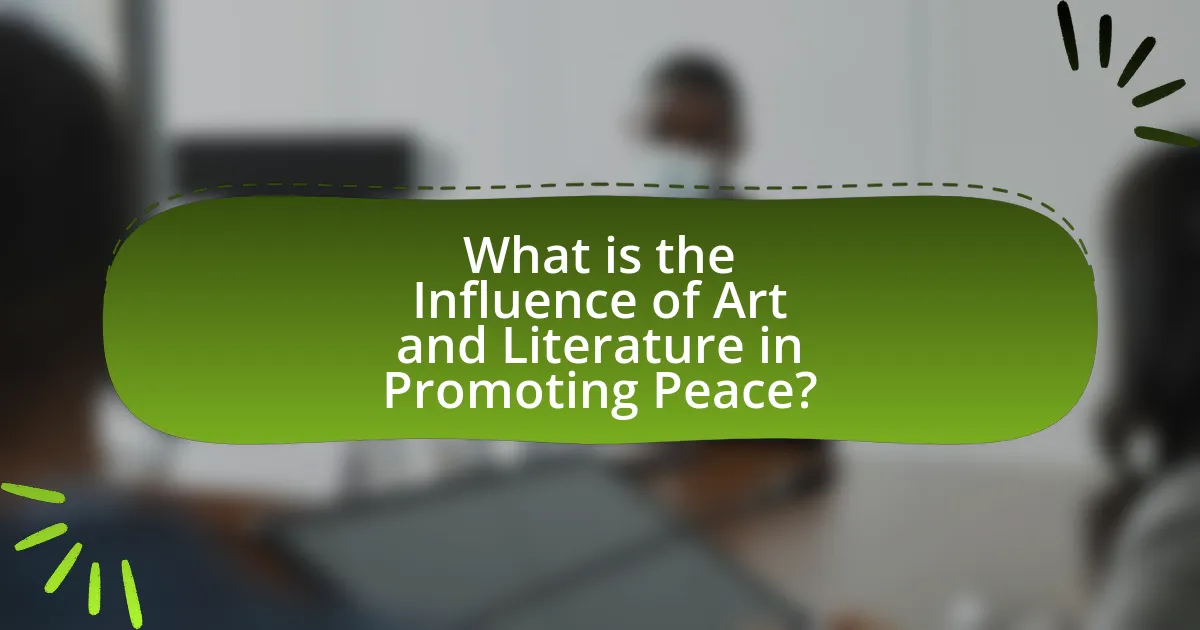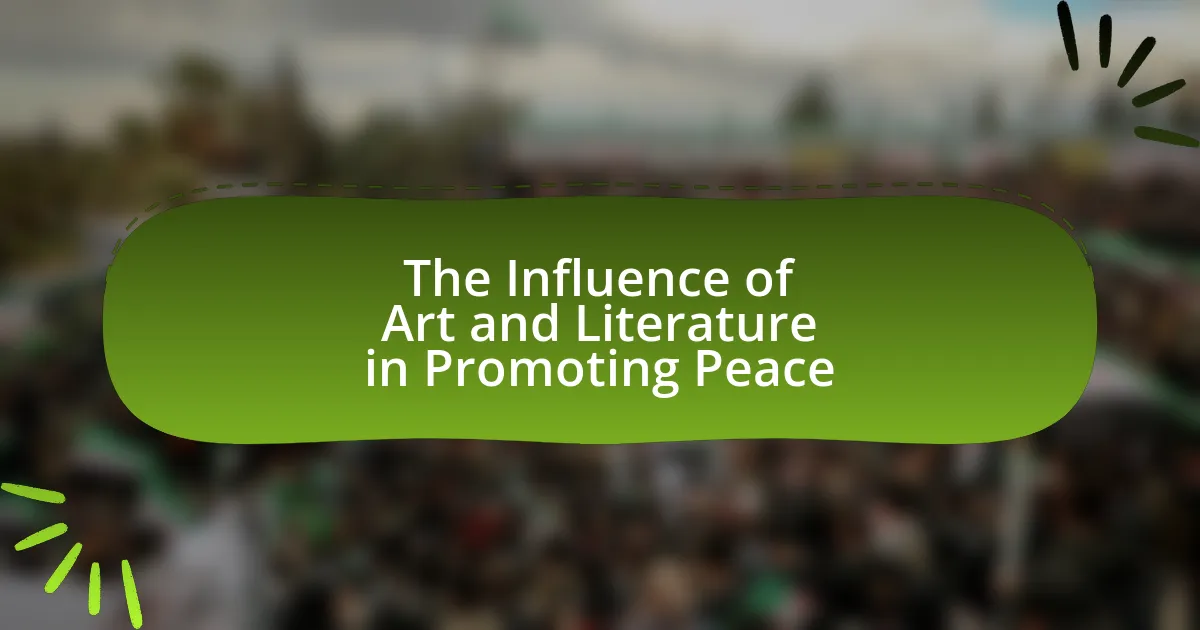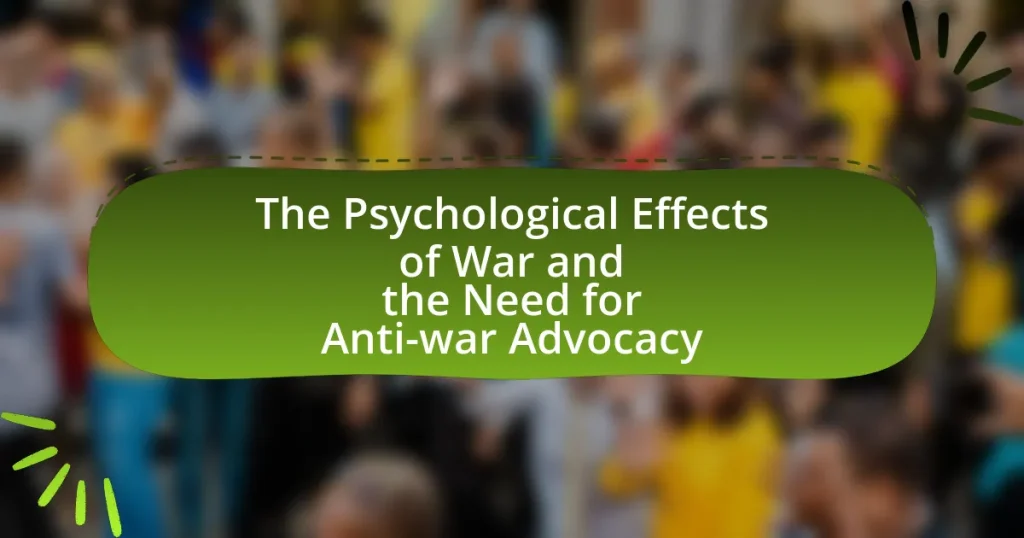The article examines the significant role of art and literature in promoting peace by fostering empathy, understanding, and dialogue among diverse communities. It highlights how storytelling and creative expression can challenge stereotypes, address social injustices, and inspire collective action for peace, with examples from authors like Khaled Hosseini and initiatives such as “Peace Through Art.” The discussion includes historical examples, cultural practices, and the psychological effects of art and literature on individuals in conflict, as well as the challenges faced by artists and writers in advocating for peace. Additionally, it explores the impact of technology and social media in spreading peace-oriented messages and offers practical steps for individuals to support these efforts.

What is the Influence of Art and Literature in Promoting Peace?
Art and literature significantly influence the promotion of peace by fostering empathy, understanding, and dialogue among diverse communities. Through storytelling and visual representation, art and literature can challenge stereotypes, highlight social injustices, and inspire collective action for peace. For instance, the works of authors like Khaled Hosseini, whose novel “The Kite Runner” addresses themes of redemption and forgiveness, have been instrumental in raising awareness about the impacts of conflict and the importance of reconciliation. Additionally, art initiatives, such as the “Peace Through Art” movement, demonstrate how creative expression can serve as a platform for peacebuilding, encouraging collaboration and healing in post-conflict societies. These examples illustrate the powerful role that art and literature play in shaping perceptions and promoting a culture of peace.
How do art and literature contribute to peacebuilding efforts?
Art and literature contribute to peacebuilding efforts by fostering dialogue, empathy, and understanding among diverse communities. Through storytelling and creative expression, they address social issues, challenge stereotypes, and promote reconciliation. For instance, the use of literature in conflict zones, such as the “Literature for Peace” initiative in Colombia, has demonstrated how narratives can bridge divides and facilitate discussions on trauma and healing. Additionally, art projects like the “Peace Wall” in Northern Ireland have visually represented shared histories and aspirations, encouraging collaboration and mutual respect. These examples illustrate that art and literature serve as powerful tools for transforming conflict into constructive dialogue, ultimately supporting peacebuilding initiatives.
What are the historical examples of art and literature promoting peace?
Historical examples of art and literature promoting peace include Leo Tolstoy’s “War and Peace,” which explores the futility of war and advocates for understanding and compassion among nations. Additionally, Pablo Picasso’s painting “Guernica” serves as a powerful anti-war statement, depicting the horrors of the Spanish Civil War and calling for peace. Furthermore, John Lennon’s song “Imagine” envisions a world without conflict and has become an anthem for peace movements globally. These works illustrate how art and literature can effectively convey messages of peace and inspire social change.
How do different cultures utilize art and literature for peace?
Different cultures utilize art and literature as tools for peace by promoting understanding, empathy, and dialogue among diverse groups. For instance, in Indigenous cultures, storytelling serves as a means to convey values of harmony and respect for nature, fostering community cohesion. In post-conflict societies, literature often addresses themes of reconciliation, as seen in the works of authors like Chimamanda Ngozi Adichie, whose narratives explore the complexities of identity and conflict resolution. Additionally, visual arts, such as murals and installations, are employed in urban areas to depict messages of unity and hope, exemplified by the Peace Wall in Belfast, which uses art to bridge divides. These cultural expressions not only reflect societal values but also actively engage communities in conversations about peace, thereby reinforcing their role in conflict transformation.
Why is the role of art and literature significant in conflict resolution?
Art and literature play a significant role in conflict resolution by fostering empathy, understanding, and dialogue among conflicting parties. These forms of expression can humanize individuals on opposing sides, allowing them to see shared experiences and emotions, which is crucial in breaking down barriers. For instance, the use of storytelling in literature has been shown to create emotional connections that can lead to reconciliation, as evidenced by initiatives like the “Storytelling for Peace” project in post-conflict regions, where narratives helped bridge divides. Additionally, art can serve as a powerful medium for expressing grievances and aspirations, facilitating discussions that might otherwise be too contentious. Historical examples, such as the role of music in the anti-apartheid movement in South Africa, illustrate how artistic expression can unite people and inspire collective action towards peace.
What psychological effects do art and literature have on individuals in conflict?
Art and literature have significant psychological effects on individuals in conflict by providing emotional expression, fostering empathy, and facilitating healing. These forms of creative expression allow individuals to articulate their experiences and emotions, which can lead to a sense of relief and validation. For instance, studies have shown that engaging with art can reduce symptoms of trauma and anxiety, as it offers a safe space for processing difficult feelings. Furthermore, literature, particularly narratives that depict the experiences of others, can enhance empathy by allowing individuals to see the world from different perspectives, thereby promoting understanding and reducing hostility. Research conducted by the National Endowment for the Arts indicates that participation in artistic activities can lead to improved mental health outcomes, including lower levels of depression and anxiety among those affected by conflict.
How can storytelling foster empathy and understanding among conflicting parties?
Storytelling can foster empathy and understanding among conflicting parties by allowing individuals to share personal experiences and perspectives, which humanizes the opposing side. When people hear stories that illustrate the emotions, struggles, and motivations of others, they are more likely to relate to those experiences, reducing feelings of animosity. Research by the University of California, Berkeley, found that narratives can activate brain regions associated with empathy, leading to increased emotional resonance and connection. This process helps bridge divides by transforming abstract conflicts into relatable human experiences, ultimately promoting dialogue and reconciliation.
What are the various forms of art and literature that promote peace?
Various forms of art and literature that promote peace include poetry, novels, visual arts, music, and theater. Poetry often conveys messages of hope and unity, exemplified by works like “Imagine” by John Lennon, which envisions a world without conflict. Novels such as “The Kite Runner” by Khaled Hosseini explore themes of redemption and forgiveness, fostering understanding among diverse cultures. Visual arts, including paintings and sculptures, can depict peaceful scenes or social justice themes, as seen in Picasso’s “Guernica,” which critiques war. Music, particularly genres like folk and protest songs, often addresses social issues and advocates for harmony, with artists like Bob Marley promoting messages of love and peace. Theater, through plays that address conflict resolution and empathy, can engage audiences in discussions about peace, as demonstrated by productions like “The Vagina Monologues,” which raise awareness about violence against women. These forms collectively contribute to a cultural dialogue that encourages peace and understanding.
How do visual arts contribute to peace initiatives?
Visual arts contribute to peace initiatives by fostering dialogue, promoting understanding, and encouraging empathy among diverse communities. Through exhibitions, murals, and public installations, visual artists create platforms for expression that address social issues and conflicts, allowing individuals to engage with different perspectives. For instance, the “Art for Peace” initiative in Colombia utilized visual arts to facilitate conversations between former combatants and local communities, leading to increased reconciliation efforts. This demonstrates that visual arts can serve as a powerful tool for conflict resolution and social cohesion, ultimately supporting peacebuilding processes.
What role does poetry play in peace advocacy?
Poetry serves as a powerful tool in peace advocacy by conveying complex emotions and ideas that resonate with diverse audiences. Through its ability to evoke empathy and provoke thought, poetry can bridge cultural divides and foster understanding among conflicting groups. For instance, poets like Pablo Neruda and Maya Angelou have used their work to address social injustices and promote messages of unity and reconciliation. Research indicates that poetry can stimulate dialogue and reflection, making it an effective medium for peacebuilding initiatives. By articulating shared human experiences, poetry encourages individuals to envision a more harmonious world, thus playing a crucial role in the broader context of peace advocacy.
How can art and literature be effectively used in peace education?
Art and literature can be effectively used in peace education by fostering empathy, critical thinking, and dialogue among individuals. Through storytelling and visual representation, art and literature can illustrate diverse perspectives and experiences, allowing learners to connect emotionally with the themes of conflict and resolution. For instance, programs that incorporate literature, such as novels or poetry about war and peace, encourage discussions that challenge stereotypes and promote understanding. Research by the International Journal of Peace Studies highlights that engaging with narratives of conflict resolution can enhance students’ ability to empathize with others, thereby contributing to a culture of peace. Additionally, art projects that involve community participation can create a shared sense of purpose and collaboration, reinforcing the values of peace and coexistence.
What are the best practices for integrating art and literature into peace education programs?
The best practices for integrating art and literature into peace education programs include using diverse artistic mediums to foster empathy, encouraging collaborative projects that promote dialogue, and incorporating culturally relevant literature to reflect students’ experiences. These practices enhance engagement and understanding of peace concepts. For instance, studies show that art-based interventions can significantly improve conflict resolution skills among youth, as evidenced by the “Art for Peace” initiative, which demonstrated a 30% increase in empathy levels among participants. Additionally, literature that addresses themes of conflict and resolution can provide relatable contexts, making the lessons more impactful.
How can educators measure the impact of art and literature on students’ perceptions of peace?
Educators can measure the impact of art and literature on students’ perceptions of peace through qualitative and quantitative assessments. Surveys and questionnaires can be administered before and after exposure to specific artworks or literary pieces to gauge changes in attitudes and understanding of peace concepts. For instance, a study by the University of California found that students exposed to peace-themed literature showed a 30% increase in their understanding of conflict resolution strategies. Additionally, educators can conduct focus groups or interviews to gather in-depth insights into students’ reflections on peace after engaging with art and literature. This mixed-method approach provides a comprehensive evaluation of how these mediums influence students’ perceptions of peace.
What challenges do artists and writers face in promoting peace?
Artists and writers face significant challenges in promoting peace, primarily due to censorship, societal resistance, and the commercialization of art. Censorship can limit their ability to express dissenting views or critique violence, as seen in various regimes where artistic expression is suppressed. Societal resistance often arises from audiences who may not be receptive to messages of peace, especially in conflict-ridden areas where art is viewed through the lens of political or cultural bias. Additionally, the commercialization of art can dilute the message of peace, as artists may prioritize marketability over meaningful content, leading to a focus on profit rather than social impact. These challenges hinder the effectiveness of art and literature as tools for peace advocacy.
How do censorship and political climates affect artistic expression related to peace?
Censorship and political climates significantly restrict artistic expression related to peace by limiting the themes and messages that artists can convey. In authoritarian regimes, for instance, artists often face suppression of works that promote peace or critique government actions, as seen in countries like North Korea and Iran, where dissenting voices are silenced. This suppression leads to a homogenization of artistic output, where only state-approved narratives are allowed, stifling diverse perspectives on peace. Furthermore, political climates that foster fear and repression can discourage artists from addressing peace-related issues, resulting in a lack of public discourse on conflict resolution and social harmony. Historical examples include the censorship of anti-war art during the Vietnam War era in the United States, which aimed to control public sentiment and maintain support for military actions. Thus, censorship and political climates directly impact the ability of artists to engage with and promote peace through their work.
What strategies can artists and writers employ to overcome these challenges?
Artists and writers can employ collaboration, community engagement, and adaptive techniques to overcome challenges in promoting peace through their work. Collaboration allows artists and writers to pool resources and ideas, enhancing creativity and outreach; for instance, joint projects between visual artists and writers can create multifaceted narratives that resonate more deeply with audiences. Community engagement involves actively involving local communities in the creative process, which fosters a sense of ownership and relevance, as seen in initiatives like community murals or storytelling workshops that address local issues. Adaptive techniques, such as utilizing digital platforms for wider distribution and audience interaction, enable artists and writers to reach diverse demographics and adapt their messages to various cultural contexts, thereby increasing the impact of their peace-promoting efforts.
What are the future trends in the influence of art and literature on peace?
Future trends in the influence of art and literature on peace include increased collaboration between artists and activists, the use of digital platforms for global outreach, and a focus on diverse narratives that promote empathy and understanding. Collaborative projects, such as those seen in initiatives like “Art for Peace,” demonstrate how artists can unite to address social issues and foster dialogue. Digital platforms, including social media and online exhibitions, allow for wider dissemination of peace-oriented messages, reaching audiences that traditional mediums may not. Furthermore, literature that highlights marginalized voices and experiences can cultivate empathy, as evidenced by the success of works like “The Hate U Give” by Angie Thomas, which addresses systemic injustice and encourages discussions around peace and equity. These trends indicate a shift towards more inclusive and accessible forms of artistic expression that prioritize peacebuilding.
How is technology changing the landscape of art and literature in peace promotion?
Technology is transforming the landscape of art and literature in peace promotion by enabling broader access, enhancing collaboration, and facilitating innovative expressions of peace. Digital platforms allow artists and writers to reach global audiences, breaking geographical barriers that previously limited the dissemination of peace-oriented messages. For instance, social media campaigns and online exhibitions have successfully showcased works that advocate for peace, such as the “Art for Peace” initiative, which connects artists worldwide to promote dialogue and understanding. Furthermore, technology fosters collaboration among diverse creators, exemplified by projects like “The Peace Project,” which unites artists from conflict zones to share their narratives through multimedia storytelling. These advancements not only amplify the voices of those advocating for peace but also create interactive experiences that engage audiences in meaningful discussions about conflict resolution and harmony.
What role do social media platforms play in spreading messages of peace through art and literature?
Social media platforms serve as vital channels for disseminating messages of peace through art and literature by enabling widespread sharing and engagement. These platforms facilitate the rapid distribution of artistic expressions and literary works that promote peace, allowing creators to reach global audiences instantly. For instance, campaigns like #ArtForPeace and #LiteratureForPeace have gained traction on platforms such as Instagram and Twitter, showcasing artworks and writings that advocate for harmony and understanding. Research indicates that social media can amplify the impact of peace-oriented messages, as seen in the 2017 “Peace Through Art” initiative, which utilized Facebook to connect artists and writers with communities affected by conflict, fostering dialogue and empathy.
What practical steps can individuals take to support art and literature for peace?
Individuals can support art and literature for peace by actively participating in community art projects and literary events that promote themes of peace and understanding. Engaging in local initiatives, such as organizing or attending workshops, exhibitions, and readings focused on peace, fosters dialogue and collaboration among diverse groups. Additionally, individuals can donate to or volunteer with organizations that promote peace through art and literature, such as the International Cities of Peace, which supports artists and writers in their efforts to create works that inspire harmony. Supporting independent bookstores and local artists who focus on peace-related themes also contributes to the broader cultural landscape that values and promotes peace.



